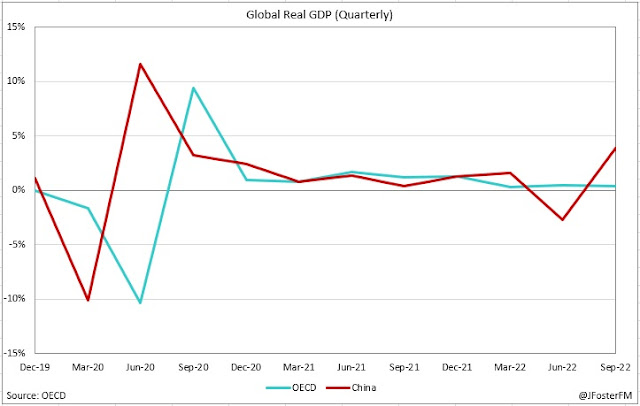Australia's September quarter national accounts are due to be published by the ABS today at 11:30am (AEDT). Markets expect Real GDP to have expanded by 0.7% in the quarter following solid growth over the first half of the year. Household spending remained resilient to cost-of-living pressures and weak sentiment as the services sector continued to rebound from the pandemic and with the strong labour market bolstering incomes.
Economic headwinds from offshore intensified in the September quarter. High inflation caused by pandemic-related effects and the war in Ukraine combined with monetary policy tightening to slow growth in OECD economies. Meanwhile, activity in China rebounded as Covid lockdowns were eased.
Strength in the domestic labour market consolidated in Q3, with the unemployment rate and overall spare capacity remaining at historical lows. Although the pace of hiring slowed, forward-looking indicators remained consistent with strong demand for labour. The tightening in the labour market had driven an uplift in wages growth to 9-year highs.
Households continued to endure a period of falling real incomes as inflation accelerated above 7% — its fastest pace since the early 1990s. In response, the RBA hiked interest rates by 150bps during the quarter. Although the full effects of rising interest rates are yet to flow through to households, consumer sentiment fell to the depths seen at the outset of the pandemic.
Despite this, solid momentum in household spending was maintained. The effects of the pandemic were continuing to dissipate and this was supporting demand for discretionary services such as travel and dining out and associated categories, notably clothing and footwear. Accumulated savings built up over the pandemic and strong labour incomes were underpinning household spending.
The transmission of the RBA's tightening cycle was starting to take effect in the housing market. Housing prices fell by around 4% nationally in Q3, with the Sydney market seeing a larger decline of 6%. Residential construction work rebounded in the quarter after being hampered by supply constraints for materials and labour and wet weather from an extended La Niña event. Non-residential building also picked up, but business investment was weak overall as equipment spending pulled back. Australia's international trade dynamics turned less favorable as prices for key commodity exports retraced from elevated levels. Import prices continued to rise, albeit at a slower pace than in prior quarters.
As it stands | National Accounts — GDP
The Australian economy expanded by 0.9% in the June quarter following a similar increase in the March quarter (0.7%). Activity over the first half of the year showed resilience to Covid and weather-related disruptions, rising cost-of-living pressures and weak consumer sentiment. Real GDP increased by 3.6% through the year and was 5.5% above its pre-pandemic level.
Household consumption remained strong rising by 2.2% in the quarter driven by the recovery in the services sector. The easing of restrictions on travel gave momentum to the rebalancing of consumption patterns, with spending increasingly rotating back to services (3.6%) from goods (-0.1%). Consumption was in large part funded by households spending more of their disposable income — in part due to high inflation — driving a reduction in the household saving ratio from 11.1% to 8.7%.
Exports contributed strongly to growth in Q2 (1ppt) as rural goods and resources production rebounded from weather-related disruptions earlier in the year. Inbound tourism also boosted exports following the full reopening of the international border. On the back of elevated prices for major export commodities, the terms of trade lifted to a record high. Import volumes consolidated (0.7%) after surging in the previous quarter (11.3%) as restrictions on offshore travel eased. Overall, net exports added 1ppt to Q2 GDP; however, that was offset by a pullback in inventories (-1.2ppt) after a rebuilding effort returned stocks to pre-Covid levels.
Private investment was soft in Q2 and over the past year. Adverse weather added to materials and labour shortages to further hamper residential construction activity (-2.9%q/q). Those headwinds have also held back non-residential building (-1.9%q/q), which weighed on business investment in Q2 (0.6%). Public demand was steady in the quarter but has risen strongly over the past year (6%). Government spending has been elevated alongside the pandemic and flood recoveries, while a substantial pipeline of infrastructure projects has supported public investment.
Key dynamics in Q3 | National Accounts — GDP
Household consumption — The post-Covid rebound in the services sector drove household spending as retail volumes slowed sharply to nearly stall in the quarter. Demand remained solid despite very weak sentiment due to cost-of-living pressures and rising interest rates.
Dwelling investment — Residential construction activity rebounded in the quarter as the effects of La Niña and supply constraints eased. New home building saw its strongest quarterly rise since late 2020, though alterations are unwinding from the peaks of the pandemic.
Business investment — Private sector capital expenditure weakened as equipment and machinery investment pulled back from strength earlier in the year. A pick up in non-residential building provided some offset as weather-related and supply disruptions eased.
Public demand — Government expenditure consolidated at high levels following the pandemic and flood responses. Public investment pulled back from recent strength. Overall, a net negative for Q3 activity.
Inventories — An easing in weather-related disruptions and supply contains enabled inventories to rise solidly in Q3, potentially adding 0.4ppt to GDP growth.
Net exports — Set to subtract 0.2ppt from quarterly activity. Import volumes (3.9%) outpaced exports (2.7%) as the services sector continued to rebound led by overseas travel. Resources export volumes were soft and key commodity prices retraced from elevated levels.










